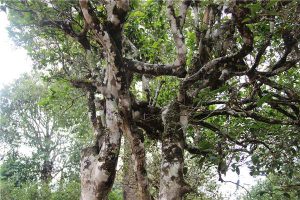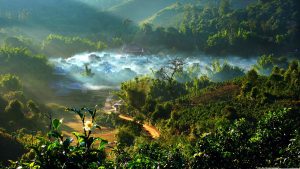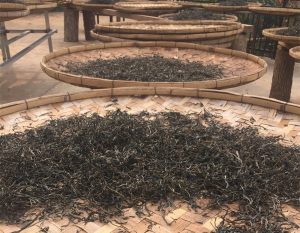
Hekai Tea Mountain in Menghai County, Xishaungbanna
Chinese Name: 勐海贺开茶山
English Name: Hekai Tea Mountain in Menghai County, XishaungBanna
Keywords: Hekai Tea Mountain in Menghai County, XishaungBanna attractions, things to do in Menghai Hekai Tea Mountain
Location: Located in the southeast of Menghai County in Hekai Village of Menghun Town
Admission Fee: Free
Opening Hours: All the day
Web: http://www.ishuocha.com/baike/hk/
Xishuangbanna Hekai Tea Mountain
Hekai Tea Mountain is located in the southeast of Menghai County in Hekai Village of Menghun Town. Hekai is one of the the biggest ancient tea gardens planted by humans. Almost one third of the Hekai area is covered by tea trees between 200 and 400 years old. The primary ethnic groups are Hani and Lahu. It is located 50km from the Menghai county seat and belongs to the northern section of the Nannuo mountain chain. Hekai Tea Mountain is divided into Manmai(曼迈) and Mannong old(曼弄老寨) and new villages(曼弄新寨). It contains Xishuangbanna’s best preserved and largest ancient tea gardens. The tea gardens are primarily distributed along mountains and hills between 1,170 and 1,800 meters. Mountains cover 93.5% of its land area. It possesses a southern subtropical, monsoonal climate and receives plentiful rainfall. The yearly average temperature of 18.1°C and relative humidity is 82%. The climate is warm and moist, providing superior natural conditions for growing tea trees. The areas around the tea mountain have luxuriant tree growth. A natural environment with excellent tree cover creates a harmonious tea garden landscape where “the forest contains tea and the tea contains a forest.” Today there are nearly 8,000mu of ancient tea gardens in the Hekai tea growing area, which produce approximately 250 tons of high quality tea per year.
As pu’er became a hot topic for tea lovers all over the globe, pu’er made from ancient tea trees became more highly sought out. This lead to an inundation of buzz words surrounding pu’er such as old tree, ancient tree, big leaf, etc. But do we really understand the meaning of these concepts? Does big leaf pu’er imply old tree? How old does a tree have to be to be called “old tree”? Similarly, how ancient is “ancient tree” pu’er?

The “oldest” tree in Hekai area has been “protected” with the fence. We quoted the word oldest because it’s considered the oldest, we cannot be sure because the only way to know the age of a tree accurately is to cut the tree trunk and count the rings. Obviously, not an option here. To estimate the age, they use data gathered from trees that have already died. Those trees are cut and their age is determined and the trunk diameters are compared to those of living trees to form an estimate. So when we talk about very ancient tea trees, to the order of 2700 to 3200 years old, we cannot be accurate because there is not much trunk diameter information available for this vintage of tree. In Hekai area, the “oldest” tea tree is a relatively large one, and there are a fair number of tea trees that are a similar trunk size, so it’s anyone’s guess which one is really the oldest.
We also quoted “protected”. Protected in the sense that a fence has been built around the tree to protect it from tourists. It a nice idea. But it’s not uncommon to hear of these “protected” ancient trees becoming weak and dying, like the 800 year old tea tree in Nannuo Shan (mountain)(南糯山) or the 500-600 year old Songzhong(宋种) (ancient tea tree of Feng Huang Dan Cong(凤凰单枞)) in Wudong Shan. The big ‘improvement’ in how to protect the tree here in Menghai is that the concrete fence was replaced by a wooden fence. A lion in the zoo is not the same as one in the wild. It’s the same with ancient tea trees, or any tea tress. Perhaps the whole area needs to be blocked off to really protect the ancient trees, so they can have an environment in which to prosper.

Characteristic of Hekai Tea
After brewing the tea, a golden bright yellow liquid will appear with its unique aroma that will fill the room. Some experienced tea lovers call it “spirit of the mountains and nature”, which refers to a rich and mellow flavor that contains floral, honey, fruits as well as the scent of grass and trees. Because of the process of blending, the soft sweetness of this tea is more obvious than other new pu’er teas. The most important characteristic of this tea is “balance”, so its taste is not too bitter or strong which makes it a highly acceptable and cost effective.
Tasting and Serving Hekai Tea – Bitter, sweet and full of energy
Dry leaves are huge. Some leaves are up to 5cm long. Time to time you can find yellow leave. The smell of dry leaves is fruity-sweet. Rinsed leaves smell very intensely fruity and sweet after honey. The first infusion 20s . Lighter infusion, very delicate astringency on the tongue and the sweetness in the aftertaste. Delicate floral taste. The second infusion again 20s – infusion has a sparkling yellow color and the taste is still soft. There is a pronounced astringency and bitterness at the back of the tongue. In the aftertaste there is a mix of sweetness with the bitterness of wild tea trees -“Gu Shu(古树)”. Sweetness is coming back into the mouth from throat -“Hui Gan(回甘)”. The bitterness remains in the mouth for a long time and is very intense with woody tones.

The third infusion – a distinctive taste, astringency is very intensive and it blends into bitterness -“Ku Se(苦涩)“. The energy – “Cha Qi” – is coming directly in the head. You can still feel it even after 7th and 8th cup. Tea has a great energy. Bitterness is less pronounced in further infusions but still preset in the mouth.
Comparing this Hekai tea with Laobanzhang(老班章), Hekai has more pronounced bitterness, it is not so honey-sweet and fragrant. For subsequent infusions there are mushroom tones present in the aftertaste on the tongue. Simply great stuff with great potential for aging.
Attraction Transportation:
We can take a shuttle bus from Menghai County to Menghun Town, then transfer a local mini-bus to Hekai Village.
Attraction Travel Tips:
· Best season to travel: March – May

 7 Days GolfingTour
7 Days GolfingTour
 8 Days Group Tour
8 Days Group Tour
 8 Days Yunnan Tour
8 Days Yunnan Tour
 7 Days Shangri La Hiking
7 Days Shangri La Hiking
 11 Days Yunnan Tour
11 Days Yunnan Tour
 6 Days Yuanyang Terraces
6 Days Yuanyang Terraces
 11 Days Yunnan Tour
11 Days Yunnan Tour
 8 Days South Yunnan
8 Days South Yunnan
 7 Days Tea Tour
7 Days Tea Tour
 8 Days Muslim Tour
8 Days Muslim Tour
 12 Days Self-Driving
12 Days Self-Driving
 4 Days Haba Climbing
4 Days Haba Climbing
 Tiger Leaping Gorge
Tiger Leaping Gorge
 Stone Forest
Stone Forest
 Yunnan-Tibet
Yunnan-Tibet
 Hani Rice Terraces
Hani Rice Terraces
 Kunming
Kunming
 Lijiang
Lijiang
 Shangri-la
Shangri-la
 Dali
Dali
 XishuangBanna
XishuangBanna
 Honghe
Honghe
 Kunming
Kunming
 Lijiang
Lijiang
 Shangri-la
Shangri-la
 Yuanyang Rice Terraces
Yuanyang Rice Terraces
 Nujiang
Nujiang
 XishuangBanna
XishuangBanna
 Spring City Golf
Spring City Golf
 Snow Mountain Golf
Snow Mountain Golf
 Stone Mountain Golf
Stone Mountain Golf

















